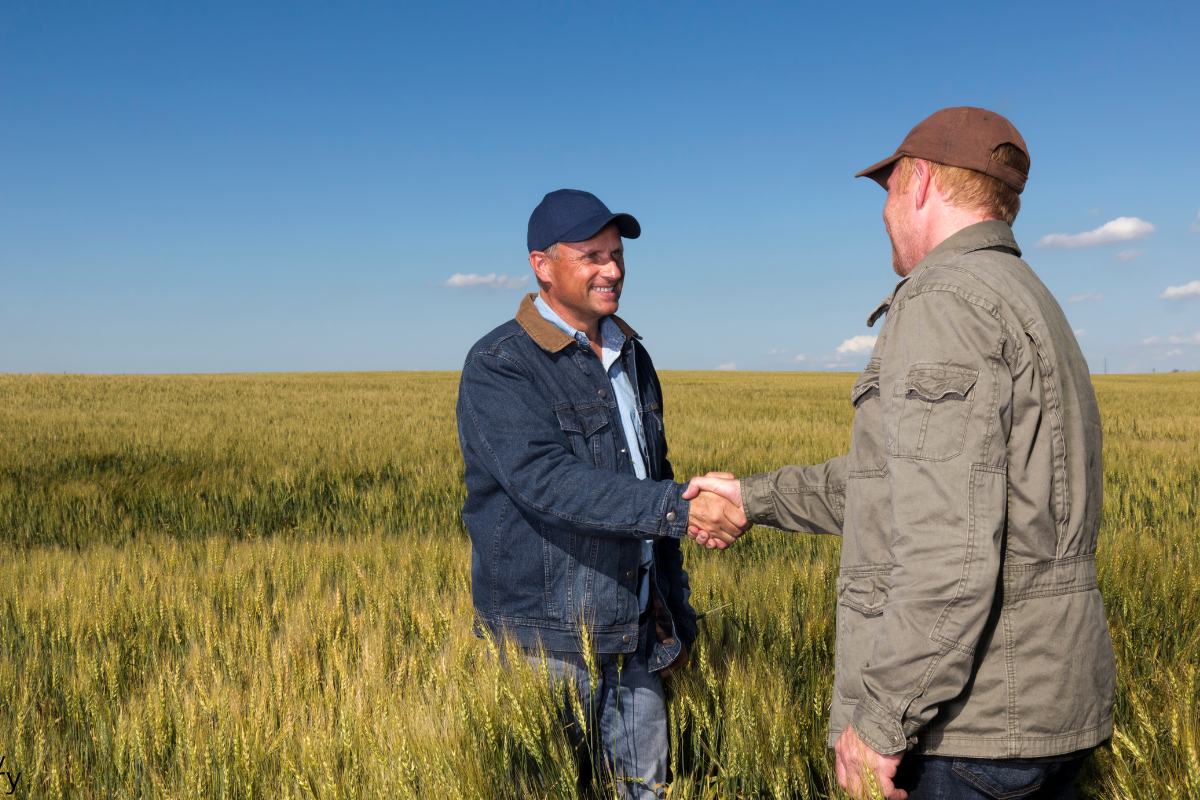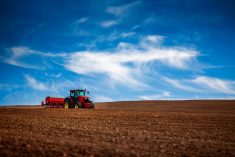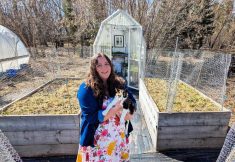When they start planning for transition to the next generation, many family farms recognize they have to increase revenue if the farm is going to support everyone full-time. But in today’s agriculture, the farm can’t always turn to the old tried-and-true solution, adding acres.
So it’s little wonder they begin asking how they might raise income on the same land base.
It’s exactly this situation that fourth-generation Alberta farmer, Kreg Alde found himself in 14 years ago when he began taking over the family farm at Beaverlodge, about five hours northwest of Edmonton, Alberta.
Read Also

Are you ready for farm succession?
What motivates some farmers to make a succession plan while others don’t seem worried.
After deciding that he needed to get into a more intensive form of agriculture, and after doing a lot of research, Alde saw potential in haskap berries, so he established an orchard in 2011 on the 2,400-acre grain farm.
Fast forward to 2024, and the Aldes’ Broken Tine Orchard sells bulk haskap berries to major food service wholesalers across Canada and it has developed several value-added products that are all produced on the farm: haskap wine, cold-pressed haskap juice, a berry ice-cream topping, and most recently, Friceys, a fruit-covered ice cream bar.
Having been round the value-added block a few times, Alde has plenty of insight to share about the process.
First is to build your network, including on the technical side where your knowledge may be weaker than you think. In his case, Alde was able to leverage the specialized equipment and expertise of the Food Processing and Development Centre in Leduc to help develop most of the products, and he admits it would have been far harder to build the business without that link.
“You can work with a food scientist and food safety people that help you to develop your food safety plan, use their equipment, and make tweaks to perfect how you’re going to produce the product once you move out of that facility,” he says.
But how does a farmer find people like food consultants, brokers and agents to help with things like branding, packaging, marketing and sales? Through being in the industry for a while, researching and by going to as many trade conferences and events as they can, advises Alde.
“Attend some conferences with other agri-preneurs and entrepreneurs in the food business,” he says. “It’ll open your eyes to a lot of people you would have never met otherwise.”
Bringing in outside expertise will be invaluable in helping busy farmers, like Alde, build their complementary value-added business, but farmers should be prepared to spend some time in the trenches themselves.
“You almost have to learn through trial and error, through your own experiences, so you understand a lot of the lingo and nuances of developing a food business,” Alde says. “You have to be ready to work your way through things before everything falls into place.”

Are you a good fit?
Value added is not for everyone, Alde says. It requires a whole different skill set from conventional farming, so it’s important to ask yourself serious questions about your own personality, skills and strengths before even considering going into a value-added enterprise.
“You have to be detail oriented,” Alde emphasizes. “I will use my dad as an example. Developing a food safety plan and all the paperwork and everything else that goes with it is beyond what he would be willing to do.”
Instead, you need to be the personality type that will excel even at the jobs that are about as unlike traditional farming as it’s possible to get.
“The biggest thing is to be really focused and patient with the process,” Alde says. “Because it does take a long time.”
In fact, Alde, who still farms their grain acres together with his dad, admits it remains hard to juggle two distinctly different and demanding business ventures. It means, he says, the value-added path is not an easy one. It’s hard.
“I hate to say it, but farming and value-added sometimes don’t mix well,” he says. “I think that’s the reason why a lot of farmers don’t go into value added because you’re a producer first, and you have to stay laser focused on your producing your crop. But, as the value-added company is growing, it doesn’t stop, and you also have to stay focused on it… your time gets really stretched.”
Grow within your means
If you do decide that value added is the route to take, Alde’s number one piece of advice is to start small.
“You can’t expect to turn into a million-dollar company selling that product in two years,” he says. “You have to grow within your means and make sure that you’re protecting your assets because the hardest part about doing this is, if you drop one client off the bat, you could be sitting on a lot of stock that you have to throw out and lose a lot of money.”
The next prerequisite is to have a good product that is differentiated in some way, and that fills a gap in the market, even if it’s a niche.
“When we developed our Friceys product we knew we wanted to create a nostalgic Creamsicle-style ice cream snack to bring back that old flavour and rich food experience,” Alde says.
But just as important as the product was their fully understanding the costs associated with producing and selling it, planning how and where they would make initial sales, and knowing the competition they would face.
Now to scale it up
Every stage of developing a value-added product requires a lot of resources, i.e., money and time, and none needs more than the marketing stage.
Maybe the marketing starts with selling to locals or attending farmers markets. After all, such methods are fairly achievable, even for a busy farmer. But once your sales are going well and you know you have the potential to grow into a larger market, that’s when the real crunch comes for many, and is often the reason why only one in 10 small businesses in the consumer-packaged goods sector make it.
“The hardest part is finding time for marketing and sales, especially if you’re into production on a farm,” Alde says.

Which leaves three alternatives: try to do it all and burn yourself out, accept that you are not going to grow any larger, or hire some outside, specialized help. That’s the option that Alde chose.
“Friceys is a prime example of a company that’s moved past the local level and we have over 120 stores throughout Alberta and British Columbia now, and we can’t do all that footwork, going store to store and having that connection, so we have hired brokers, sales agents and demo teams to assist with those sales.”
Overnight riches?
Another pill that can be hard to swallow with scaling up a business to the next level is that you aren’t going to be making much money for a while.
“To scale up to that next step, because you’ve had to spend money now on marketing costs and things like different case packaging, and agents and brokers, you won’t make any money those next couple of years,” Alde says. “You’re investing for your future, and that’s the next hardest step.”
Of course there will likely be needs for financing, which is one area where farmers do have some advantages because they have a land asset that they can potentially use to leverage funds.
“As a farmer, when you own land, it’s the number one asset that lenders want as far as security,” Alde says. “So, as long as you’re within your means and you’ve got a really good business and marketing plan, you’re probably going to be able to get a loan.”
It also means that the farmer can retain equity in their value-added business, which non-ag business owners must often give up if they need to seek alternate financing such as venture capital.
Still, there are limits, even for established farmers. Land, equipment and buildings will provide some security, but for a value-added business that is growing fast, most of its assets may already be encumbered and it’s the potential growth and profitability of the business that attracts investors.
That means the farmer has to “sell” the potential of the business to investors, and be willing to give up some equity in exchange for capital that can be used to move the business forward.
It’s not a concept that many farmers are comfortable with.
“With the farm, we have been able to organically grow our business slower and maintain most of our equity,” Alde says. “Right now, we’ve maintained all of it so we’re happy with where we’re at. But some people are different, they want to grow quicker,” Alde says. “Without an asset base, they will have to give up some equity, because they’re going to need somebody else’s money.”
A partnership to establish a new market
Alde’s Broken Tine Orchards at Beaverlodge has also used a partnership strategy to expand beyond the value-added business and his 2,400-acre grain farm growing haskap berries that he sells to food service suppliers, together with his own line of products including the ice cream topping and fruit-coated ice cream bar called Friceys.
He has partnered with other haskap growers across the Prairies to form Vitalaberry Farms, a marketing group that was set up to develop a sustainable haskap market in Canada.
“Haskap was such a new fruit that we didn’t want to splinter the industry and we wanted to make sure food safety was top notch, and that packaging and fruit quality was consistent so, that way, there was no train wrecks in the industry so people would not stop using haskap berries,” Alde says.
“We sell bulk berries through that company to Sysco and Gordon Food Service (GFS), so any time you see haskaps in a restaurant now, more than likely it’s from this group.”
Alde admits it hasn’t always been easy to work together.
“At one time there were 14 of us, all independent business owners, all trying to work to the common good, and there were lots of strong opinions.
“Although it’s been hard, we have accomplished what we set out to do and haskap now is widely accepted and getting more popular in not only food but also for specialty spirits and beers.”
Alde says the partnership worked because they were all new agri-preneurs starting out. In other words, they weren’t established businesses each with their own products and ways of doing things. They also never lost sight of their common goal to establish a new food product in the food chain, something that no one individual grower would have been able to do alone.
“We had a common goal. We wanted the food service industry to buy our berries, and the food service industry does not like buying from individual growers because if you ever have a supply issue then they have to source out, so they wanted to have a guarantee that we were going to meet their demand,” he says. “It was important that we kept our eyes on our goal, and changed and adapted as the industry matured, and as the group matured, and that’s what we’ve been able to do.”
Is it right for you?
Alde doesn’t want to sugar-coat the fact that running a successful value-added business alongside a working farm is tough.
It’s also rewarding, he says. “But it can be the worst roller coaster of all.”
“The one thing I tell people is to be creative. Don’t be afraid to let your mind go to what you could possibly create, especially if you have something that everyone says is amazing. Pursue it slowly but if you do it properly and are creative within your means, it helps your mindset, and your view on life.”
Find the right fit
Once you’ve decided it’s time to look for a new business advisor, follow these steps to make sure the new advisor is the right choice for a long-term partnership.
Ask for referrals
Tap into your peer network. Ask about their experiences with farm advisors. Then research their recommendations. Focus on reviews from operations that are similar in structure and size to yours to ensure the advisor will have the background and experience to meet your needs.
If you prefer to keep your search for a farm advisor more confidential, the Canadian Association of Farm Advisors office can also help you identify potential farm advisors.
Schedule interviews
Selecting a farm advisor is similar to hiring for other roles within the organization. Evan Shout, CFO at Hebert Grain Ventures, recommends you interview several candidates and ask pointed questions to make sure the match is good. Your list of interview questions could include:
- Tell me about your credentials and experience.
- What makes you a good fit for our farming operation?
- What services do you provide?
- Who else is on your team?
- How do you prefer to communicate?
- How long does it typically take you to return calls or respond to emails?
- Can you provide references?
Share some info
Providing background information about the farm business allows a potential farm advisor to demonstrate their skill. You can also gain insight into whether their recommendations are right for your operation.
In fact, the advisor may ask for that background. For his discovery calls, for instance, Thomas G. Blonde, partner at Baker Tilly GWD, asks for information about the history and structure of the business, including tax returns and financial statements.
“We want to identify right away if there were mistakes or some major planning opportunity that was missed. It’s the way that we demonstrate our value with a prospective client,” Blonde says. “If I can say, ‘I’ve spent an hour looking through your stuff and here are a dozen things that we immediately identified that we would be able to help you out on,’ it shows there is value in switching to us.”
Be patient
When you’re unhappy with your current advisor, it’s tempting to drop them and then search for someone new. Blonde believes that’s a mistake.
“It might take some time to find a new advisor,” he says. “You don’t want to be in a situation where you’ve cut ties with your previous advisor and then you need them to file a tax return or prepare a financial statement because you haven’t found someone new.”
Instead, Blonde recommends signing on with someone new before breaking up with your current advisor. He adds that maintaining a cordial relationship can help with a smooth transition and ensures that your new advisor can get the information they need from the previous advisor.
Value-added resources
Pivot and Grow website: An On-Farm Grain Processing curriculum that provides producers who may be interested in adding value to the grains they grow.
Value-Added Branch – Manitoba Agriculture
Manitoba Agriculture Food Development Centre (Portage la Prairie, Manitoba)
Value-Added Processing in Saskatchewan Agriculture
Saskatchewan Food Industry Development Centre
Alberta On-Farm Value-Added Program
Food Processing Development Centre (Leduc, Alberta)
5 critical questions: Advice from the value-added trenches
Value-added enterprises on the farm come in all shapes and sizes. It could be an on-farm or online store that markets farm-derived products direct to consumers, retailers or food service outlets. Or it could be a grain mill or processing facility, a food production facility or a brewery or winery. Or it might be an agri-tourism venture an on-farm restaurant, bed and breakfast, corn maze, U-pick or pumpkin patch.
Whatever form a value-added venture takes, though, it’s important to know that it’s going to be a totally different experience than farming.
Not least of those challenges is the fact that farmers who are more used to high-volume, bulk commodity-style agriculture may have a hard time shifting their mindset around the value-added world.
“Even the biggest and most successful direct marketing processors will sell much smaller volumes than most farmers will,” says Amy Nikkel of Adagio Acres, an organic farm that she and husband, Donald, own and operate in the Interlake region of Manitoba.
The farm has a small batch seed cleaning and grain milling facility for (mainly) specialty organic grains that they sell to retailers and direct to consumers through a winter grain CSA (community supported agriculture) in collaboration with other organic farmers.
Says Nikkel: “Where a farmer is looking at selling hundreds or thousands of tons, they have to start thinking in terms of pounds and grams, not truckloads. That might translate into ‘what can I do with this five-acre pocket of my farm while the other 10,000 acres keeps on rolling’?”
Farm size is always an important part of the calculation. Value added can be the way that smaller farmers who don’t have a large land base can make a decent living without a huge investment.
“We operate as a small farm and generally crop less than 100 acres, but we are running a business operation that employs us and a small staff as well,” Nikkel says. “For small farmers, particularly those who are starting out new, they don’t have to invest in thousands of acres of land.”
On larger farms, by contrast, a value-added enterprise will rarely if ever replace what they are already doing. Instead, the value-added venture will be complementary to the main operation.
But that doesn’t mean the value-add opportunity would be merely a distraction. Instead, value adding can be synergistic for large farm operations, offering opportunities to accommodate more of the next generation in a different way than the traditional farm transition.
“If the tractor seats are filled and you have the people to do the production side of things, and if more people want to be involved in that larger operation, by carving out a small niche in it, you have all those synergies of a large operation with access to capital, access to buildings, access to grain bins and augers and storage, so that you can potentially jump into something like on-farm processing,” Nikkel says.
#1 Do you have what it takes for value added?
While farmers should be passionate about the value-added enterprise they want to start, they need to recognize that farming and value-added are different business models that demand different skill sets.
Value add puts pressure on your marketing, communications, processing and, potentially, your manufacturing knowledge.
“The attributes that farmers have, like being able to problem solve, think for themselves and adapt to different situations, are important whether you’re farming or food processing,” says Nikkel. “Farmers may be good at fixing their farm equipment, but that skill set may (or may not) transfer over to designing and setting up processing equipment.”
When it comes to communication skills, it takes a lot more than simply being good at meeting people and telling them about your product.
“Written communication skills are important in terms of designing website content or developing a spec sheet or a food safety plan that will be compliant across provincial or country borders,” Nikkel says. “So, you need someone who’s detail oriented and analytic, and that’s a very specific skill set. Someone who’s outgoing and loves chatting about their favourite recipe can also be well-suited to direct marketing or on-farm processing, but all these skills are needed.”
#2 How do you know there’s a market?
“Be sure that you have a market before you start,” says Rosemary Wotske, who has owned and operated Poplar Bluff Organics in Wheatland County, Alta., since 1985, specializing in different varieties of potatoes that she markets to both the food service and retail sectors.
“Start at the end and work backwards,” she advises. “Ask around. Who would be interested in buying your product? Find out what prices are and then figure out if you, as a beginner, could get a toehold in the market.”
While farmers have an understanding of how to sell farm commodities, they may not be able to easily translate that knowledge into a strategy for marketing a value-added product.
“As farmers, we learn the ins and outs of trends in marketing and sometimes this can be an advantage and sometimes not because these are global trends,” Nikkel says. “You might think, what are the global trends in the consumption of this type of lentil or that type of pulse or this type of wheat flour? But whether that actually matches the community that you live in can be a totally different question. Sometimes, keeping an eye on larger global trends of farm marketing will blind us to who you could sell to locally.”
#3 Can you sweat the details?
“It will take (paperwork) to the next level if you’re doing food processing,” Nikkel says. “Your requirements for food safety inspections far outweigh the kind of documentation that comes with farming. If you are already lacking in those skills, and find it difficult to meet those organizational criteria for farming, it’s probably not a good idea to add something like food processing.”
“Whatever you think it is going to take you to get this on the road, take that and double it,” Wotske adds.
“You don’t know what you don’t know until you get there, so you have to mentally shore yourself up for the discouraging moments,” she says. “Because you’re going to have lots of them.”
Wotske has had a longtime partnership with another producer who grows carrots and beets, and having developed products including potato vodka and a cold-pressed carrot juice, she has a lot of experience in value added, but her recent experiences with developing an on-farm distillery and steakhouse have elevated the process to a new level.
She advises farmers to prepare for a lot of red tape, especially if their plan involves building a new facility on the farm or significantly repurposing an existing building. They will have to go through local planning boards and deal with processes to subdivide and, in some cases, rezone the land and buildings. It’s a process that can take a long time.
After trying to work through these stages herself, Wotske finally hired a professional planner to get results.
Just make sure that you do as much research and preparation as you can so you are as prepared as you can be for what you are getting into, advises Nikkel.
“There are people that get halfway into an endeavour and then uncover some type of regulatory hurdle that’s either not possible to navigate past, or that they don’t have the skill set to navigate past,” she says. “Leave no stone unturned in terms of rules and regulations. Anything that seems a little opaque, or that you are not quite sure about, those are the things you need to look at first.”
#4 Do you have the money?
Although farmers may understand the farm’s financial statements, balance sheet and cash flow requirements, they need to understand that a value-added business requires additional resources from the operating and capital investment perspectives, and it may not be as straightforward to access that capital as it might be if they were buying more land or equipment to expand the farm.
While having farm assets to leverage can be an advantage, the capital-intensive nature of farming today can, conversely, offer challenges for an additional enterprise on the farm.
“If everything is paid off, it might enable you to invest some capital for a processing facility or equipment. Or sometimes the farm can make it entirely impossible because you’re already maxed out,” Nikkel says.
#5 Where will you go to learn more?
The consensus is clear. Your best way to learn is to learn from others who have experience in the industry segment that you are considering.
“Go and find someone who’s doing something similar to what you want to do and make friends,” Nikkel says. “Spend a couple of days at their place, but get outside of your own geographic area. We toured other grain mills in Eastern Canada and they were enthusiastic and welcoming, and talked to us frankly about the ins and outs, what kind of equipment they had disasters with, what they’d recommend and what their best products were. We gained more knowledge from that than if we had accessed a thousand websites.”
Some provinces have Food Development Centres that can assist with developing products and can even connect farmers to sources of grant research funding. But there’s really no alternative to beating the bushes to make connections and build relationships, says Wotske.
“When I started, I talked to everybody I could think of and asked them who do you know, what do you think?” she says. “There are extension people with the province and they’re a good starting point, but you have to follow leads and see where they go. Ninety percent of them will be dead ends, so you start back with another trail and follow that to the end. Just be tenacious because it takes time, effort and optimism.”
















